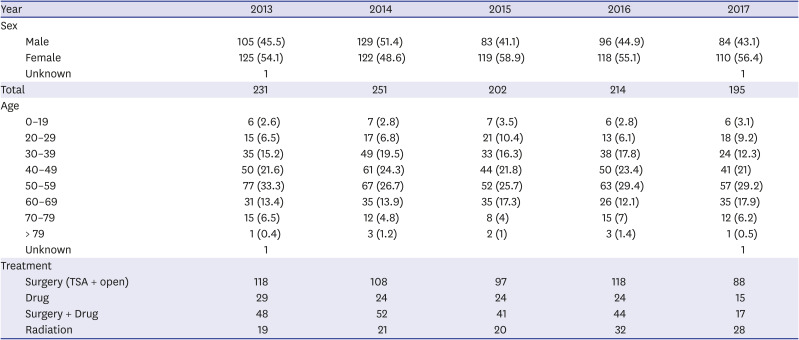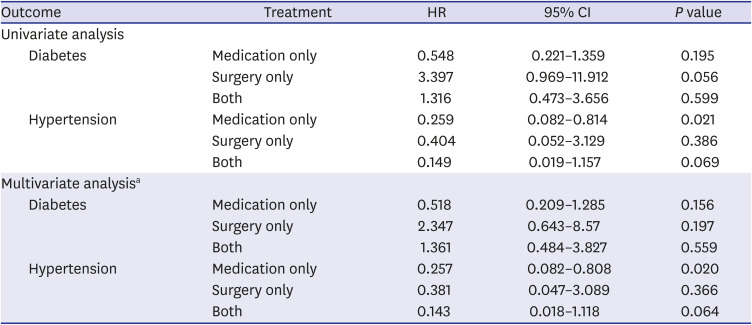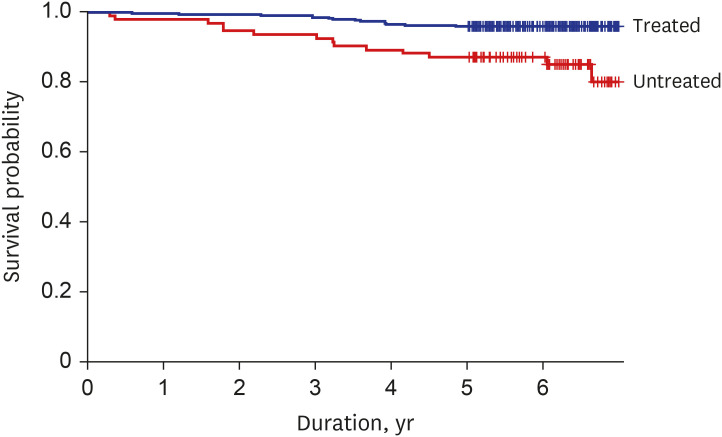1. Melmed S. Acromegaly pathogenesis and treatment. J Clin Invest. 2009; 119(11):3189–3202. PMID:
19884662.

2. Melmed S. Acromegaly and cancer: not a problem? J Clin Endocrinol Metab. 2001; 86(7):2929–2934. PMID:
11443145.
3. Holdaway IM, Bolland MJ, Gamble GD. A meta-analysis of the effect of lowering serum levels of GH and IGF-I on mortality in acromegaly. Eur J Endocrinol. 2008; 159(2):89–95. PMID:
18524797.

4. Dekkers OM, Biermasz NR, Pereira AM, Romijn JA, Vandenbroucke JP. Mortality in acromegaly: a metaanalysis. J Clin Endocrinol Metab. 2008; 93(1):61–67. PMID:
17971431.

5. Melmed S, Bronstein MD, Chanson P, Klibanski A, Casanueva FF, Wass JA, et al. A Consensus Statement on acromegaly therapeutic outcomes. Nat Rev Endocrinol. 2018; 14(9):552–561. PMID:
30050156.

6. Lavrentaki A, Paluzzi A, Wass JA, Karavitaki N. Epidemiology of acromegaly: review of population studies. Pituitary. 2017; 20(1):4–9. PMID:
27743174.

7. Yang IM. Clinical characteristics of acromegalic patients in Korea. J Korean Endocr Soc. 1994; 9(4):290–306.
8. Kwon O, Song YD, Kim SY, Lee EJ; Rare Disease Study Group, Science and Research Committee, Korean Endocrine Society. Nationwide survey of acromegaly in South Korea. Clin Endocrinol (Oxf). 2013; 78(4):577–585. PMID:
22909047.

9. Park KH, Lee EJ, Seo GH, Ku CR. Risk for acromegaly-related comorbidities by sex in Korean acromegaly. J Clin Endocrinol Metab. 2020; 105(4):e1815–26.

10. Holdaway IM, Rajasoorya RC, Gamble GD. Factors influencing mortality in acromegaly. J Clin Endocrinol Metab. 2004; 89(2):667–674. PMID:
14764779.

11. Kauppinen-Mäkelin R, Sane T, Reunanen A, Välimäki MJ, Niskanen L, Markkanen H, et al. A nationwide survey of mortality in acromegaly. J Clin Endocrinol Metab. 2005; 90(7):4081–4086. PMID:
15886256.

12. Bolfi F, Neves AF, Boguszewski CL, Nunes-Nogueira VS. Mortality in acromegaly decreased in the last decade: a systematic review and meta-analysis. Eur J Endocrinol. 2018; 179(1):59–71. PMID:
29764907.

13. Wen-Ko C, Szu-Tah C, Feng-Hsuan L, Chen-Nen C, Ming-Hsu W, Jen-Der L. The impact of diabetes mellitus on the survival of patients with acromegaly. Endokrynol Pol. 2016; 67(5):501–506. PMID:
26884300.
14. Seong SC, Kim YY, Khang YH, Park JH, Kang HJ, Lee H, et al. Data resource profile: the National Health Information Database of the National Health Insurance Service in South Korea. Int J Epidemiol. 2017; 46(3):799–800. PMID:
27794523.
15. Bae SO, Kang GW. A comparative study of the disease codes between Korean national health insurance claims and Korean national hospital discharge in-depth injury survey. Health Policy Manag. 2014; 24(4):322–329.

16. Bridgman PW. The Logic of Modern Physics. New York, NY, USA: Macmillan;1927.
17. National Health Insurance Service. National Health Insurance System of Korea. Wonju, Korea: National Health Insurance Service;2015.
18. Gadelha MR, Kasuki L, Lim DS, Fleseriu M. Systemic complications of acromegaly and the impact of the current treatment landscape: an update. Endocr Rev. 2019; 40(1):268–332. PMID:
30184064.

19. Vila G, Luger A, van der Lely AJ, Neggers SJ, Webb SM, Biller BM, et al. Hypertension in acromegaly in relationship to biochemical control and mortality: global ACROSTUDY outcomes. Front Endocrinol (Lausanne). 2020; 11:577173. PMID:
33329385.

20. Vitale G, Pivonello R, Auriemma RS, Guerra E, Milone F, Savastano S, et al. Hypertension in acromegaly and in the normal population: prevalence and determinants. Clin Endocrinol (Oxf). 2005; 63(4):470–476. PMID:
16181242.

21. Ferraù F, Albani A, Ciresi A, Giordano C, Cannavò S. Diabetes secondary to acromegaly: physiopathology, clinical features and effects of treatment. Front Endocrinol (Lausanne). 2018; 9(358):358. PMID:
30034367.

22. Kamenicky P, Viengchareun S, Blanchard A, Meduri G, Zizzari P, Imbert-Teboul M, et al. Epithelial sodium channel is a key mediator of growth hormone-induced sodium retention in acromegaly. Endocrinology. 2008; 149(7):3294–3305. PMID:
18388193.

23. Bielohuby M, Roemmler J, Manolopoulou J, Johnsen I, Sawitzky M, Schopohl J, et al. Chronic growth hormone excess is associated with increased aldosterone: a study in patients with acromegaly and in growth hormone transgenic mice. Exp Biol Med (Maywood). 2009; 234(8):1002–1009. PMID:
19491373.

24. Powlson AS, Gurnell M. Cardiovascular disease and sleep-disordered breathing in acromegaly. Neuroendocrinology. 2016; 103(1):75–85. PMID:
26227953.

25. Bondanelli M, Ambrosio MR, degli Uberti EC. Pathogenesis and prevalence of hypertension in acromegaly. Pituitary. 2001; 4(4):239–249. PMID:
12501974.
26. Colao A, Auriemma RS, Galdiero M, Lombardi G, Pivonello R. Effects of initial therapy for five years with somatostatin analogs for acromegaly on growth hormone and insulin-like growth factor-I levels, tumor shrinkage, and cardiovascular disease: a prospective study. J Clin Endocrinol Metab. 2009; 94(10):3746–3756. PMID:
19622615.

27. Helseth R, Carlsen SM, Bollerslev J, Svartberg J, Øksnes M, Skeie S, et al. Preoperative octreotide therapy and surgery in acromegaly: associations between glucose homeostasis and treatment response. Endocrine. 2016; 51(2):298–307. PMID:
26179177.

28. Kinoshita Y, Fujii H, Takeshita A, Taguchi M, Miyakawa M, Oyama K, et al. Impaired glucose metabolism in Japanese patients with acromegaly is restored after successful pituitary surgery if pancreatic {beta}-cell function is preserved. Eur J Endocrinol. 2011; 164(4):467–473. PMID:
21285083.
29. Shekhawat VS, Bhansali S, Dutta P, Mukherjee KK, Vaiphei K, Kochhar R, et al. Glucose-dependent Insulinotropic Polypeptide (GIP) Resistance and β-cell Dysfunction Contribute to Hyperglycaemia in Acromegaly. Sci Rep. 2019; 9(1):5646. PMID:
30948746.

30. Kim DJ, Lee MS, Kim KW, Lee MK. Insulin secretory dysfunction and insulin resistance in the pathogenesis of Korean type 2 diabetes mellitus. Metabolism. 2001; 50(5):590–593. PMID:
11319722.

31. Henry RR, Ciaraldi TP, Armstrong D, Burke P, Ligueros-Saylan M, Mudaliar S. Hyperglycemia associated with pasireotide: results from a mechanistic study in healthy volunteers. J Clin Endocrinol Metab. 2013; 98(8):3446–3453. PMID:
23733372.

32. Strowski MZ, Parmar RM, Blake AD, Schaeffer JM. Somatostatin inhibits insulin and glucagon secretion via two receptors subtypes: an in vitro study of pancreatic islets from somatostatin receptor 2 knockout mice. Endocrinology. 2000; 141(1):111–117. PMID:
10614629.
33. Gadelha MR, Bronstein MD, Brue T, Coculescu M, Fleseriu M, Guitelman M, et al. Pasireotide versus continued treatment with octreotide or lanreotide in patients with inadequately controlled acromegaly (PAOLA): a randomised, phase 3 trial. Lancet Diabetes Endocrinol. 2014; 2(11):875–884. PMID:
25260838.







 PDF
PDF Citation
Citation Print
Print






 XML Download
XML Download